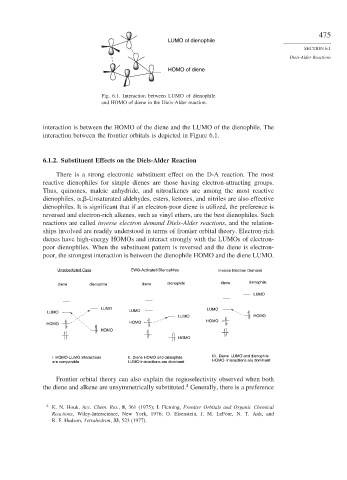Page 501 - Advanced Organic Chemistry Part B - Reactions & Synthesis
P. 501
475
LUMO of dienophile
SECTION 6.1
Diels-Alder Reactions
HOMO of diene
Fig. 6.1. Interaction between LUMO of dienophile
and HOMO of diene in the Diels-Alder reaction.
interaction is between the HOMO of the diene and the LUMO of the dienophile. The
interaction between the frontier orbitals is depicted in Figure 6.1.
6.1.2. Substituent Effects on the Diels-Alder Reaction
There is a strong electronic substituent effect on the D-A reaction. The most
reactive dienophiles for simple dienes are those having electron-attracting groups.
Thus, quinones, maleic anhydride, and nitroalkenes are among the most reactive
dienophiles. , -Unsaturated aldehydes, esters, ketones, and nitriles are also effective
dienophiles. It is significant that if an electron-poor diene is utilized, the preference is
reversed and electron-rich alkenes, such as vinyl ethers, are the best dienophiles. Such
reactions are called inverse electron demand Diels-Alder reactions, and the relation-
ships involved are readily understood in terms of frontier orbital theory. Electron-rich
dienes have high-energy HOMOs and interact strongly with the LUMOs of electron-
poor dienophiles. When the substituent pattern is reversed and the diene is electron-
poor, the strongest interaction is between the dienophile HOMO and the diene LUMO.
Unsubstituted Case EWG-Activated Dienophiles Inverse Electron Demand
diene dienophile diene dienophile diene dienophile
LUMO
LUMO LUMO
LUMO LUMO
LUMO HOMO
HOMO HOMO HOMO
HOMO
HOMO
I. HOMO-LUMO interactions II. Diene HOMO and dienophile III. Diene LUMO and dienophile
are comparable LUMO interactions are dominant HOMO interactions are dominant
Frontier orbital theory can also explain the regioselectivity observed when both
4
the diene and alkene are unsymmetrically substituted. Generally, there is a preference
4
K. N. Houk, Acc. Chem. Res., 8, 361 (1975); I. Fleming, Frontier Orbitals and Organic Chemical
Reactions, Wiley-Interscience, New York, 1976; O. Eisenstein, J. M. LeFour, N. T. Anh, and
R. F. Hudson, Tetrahedron, 33, 523 (1977).

